Patients who were seeking treatment following dog bites were screened at OPD.
They had to queue with the other patients until their turn and after the consultations some of them were directed to MRI for specialized opinion. On those occasions they had to find a mode of transport on their own and go there and come back again to NHSL for treatment.
Some were admitted to the medical wards for immunoglobulin and had to wait for hours to get treatment. Medical wards which are already burdened with various medical emergencies were unable to give priority to Rabies post exposure patients were unable to prioritize.
So called lucky ones with negative skin test for the available horse serum, received serum at wards after long waiting and had to go back to the OPD injection room for the next step of treatment (ARV on following day).
Some who were fed-up after long stay in ward did not ever visited OPD for ARV and even developed rabies and died.
Patients who were tested allergic to available horse serum had to be in the ward until expensive human immunoglobulin was purchased. It took even several days and some left against medical advice.
At the OPD with various medical conditions and enormous number of patients rabies victims also had to go to injection room doctor for ARV injection.
There was no way to track a patient after leaving medical ward or injection room because only record which was available was injection room ARV book which had only name and age of the patient.
Patients defaulted at every level from the moment they came to OPD at the very beginning.
On March 2005 a Medical Officer who worked as a senior house officer to ward 55 (Medical Ward), prepared and forwarded a proposal for creating a separate Rabies Post Exposure Treatment Unit to the Director of the National Hospital of Sri Lanka which was sent to the Medical Research Institute (MRI) and the Director general of Health Services and was approved after several discussions.
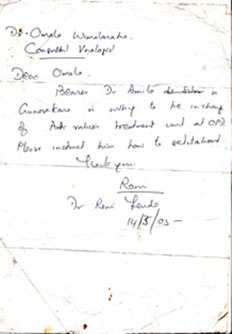
The first request made to the initiation of the Rabies Treatment Unit of the NHSL.
Finding a room was an uphill task and many were of the opinion that establishing a unit of this nature in OPD will lead to greater problems.
A room which was used for Anti-Rabies Vaccinations and staff room were selected for this purpose.
The biggest issue was to attend repairs when the room was functioning form 8.00 am to 6.00 pm.
Floor tiling, painting and celling repairs had to be done in the night time. Furniture was provided with the help of a well-wisher.
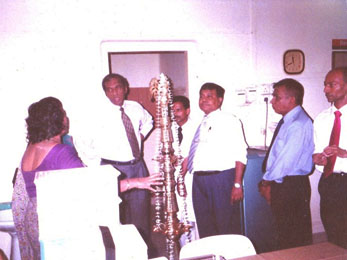
On 09/04/2005 Rabies unit was opened officially by Dr Hector Weerasinghe (Director NHSL during that period) and Dr Rani Fernando (Deputy Director during that period).
There were no other Medical Officers allocated for the unit other than the Medical Officer who initiated the unit. He had to work from 8.00 am to 6.00pm all seven days alone for more than three months.
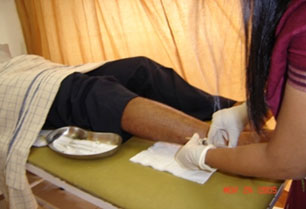
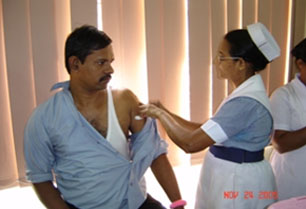
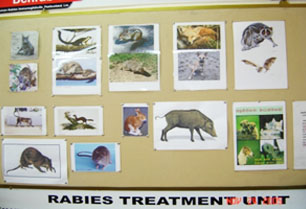
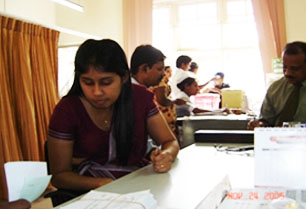
Patients were registered in separate register instead of an OPD chit
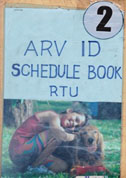
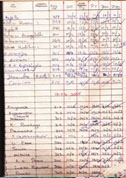
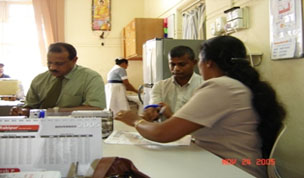
Patients were made to wear colour code bands depending on treatment to avoid mismanagement
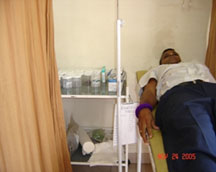
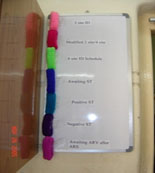
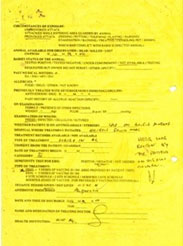
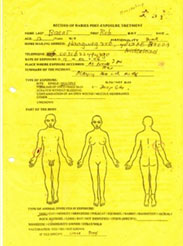
Rabies exposure record form replaced the register with more accurate detail
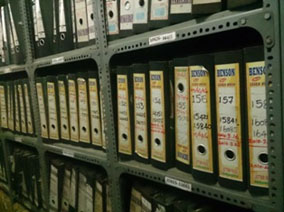
Collected records occupied a lot of space inside the unit and to avoid that the Rabies Treatment Unit record room was created.
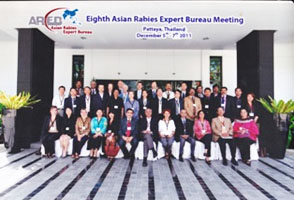
Rabies Unit was represented in Asian Rabies Expert Bureau from 2006.
WHO teams visited the Unit several times and it was highly recognized as a model unit.
The Asia Foundation named the Colombo National Hospital Rabies Unit as one of the best such units in the world.

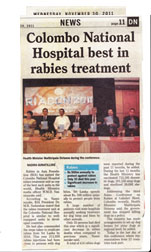
Awards and the appreciations received by the Rabies Treatment Unit
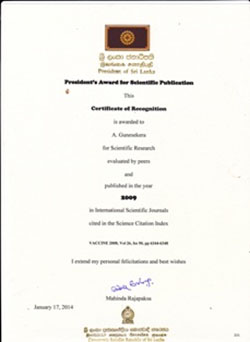
As the time passed by a more sophisticated method of registering the patients and maintaining records were introduced and that too was succeeded by the state of the art on line registering mechanism subsequently introduced to the unit.
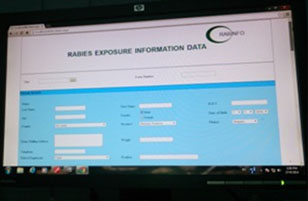
With the introduction of the software based data entry system it was easy to retrieve the patient data and it helped to increase the accuracy and the efficiency of the patient follow up. In addition great deals of patient details are saved in the system which helps to find the defaulters and also to communicate with the patients when necessary.
The saved data in the system is also having an epidemiological value.
Operational Time Period
On Weekdays- 8.00am to 6.00pm
On Sunday and Public Holidays- 8.00am to 4pm
Main functions of Rabies Unit
-
Screening and treatment ( inward and as out patients)of patients
-
Medical training on rabies for doctors and nurses from other hospitals
-
In house training
-
Outreach training by visiting to other hospital upon their request
-
- Epidemiological data collection
Future Plans
In future it is planned to upgrade the software and introduce a web based data entry system. This might help to link all the Rabies Treatment Units of the country to get the patient data online from any of the Rabies Treatment Units in the country and also the staffs of the units can get the latest updates of the of Rabies Pre and Post exposure managements.
Once this system is introduced the patients will be able to log into the system with their ID and review the treatment they have received when necessary.







